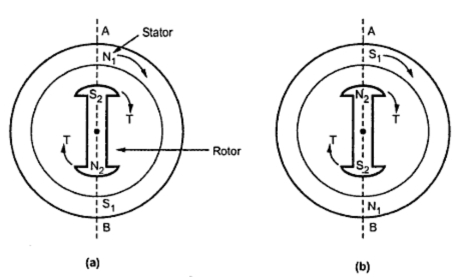Now suppose the rotor is rotated by some external means at a speed almost equal to synchronous speed. And then the rotor is excited to produce its poles. At a certain instant now, the stator and rotor unlike poles will face each other such that their magnetic axes are near each other. Then the force of attraction between the two, pulls both of them into the magnetic locking condition.
Once magnetic locking is established, the rotor and stator poles continue to occupy the same relative positions. Due to this, rotor continuously experiences a unidirectional torque in the direction of the rotating magnetic field. Hence rotor rotates at synchronous speed and said to be in synchronism with rotating magnetic field. The external device used to rotate rotor near synchronous speed can be removed once synchronism is established. The rotor then continues its rotation at Nsdue to magnetic locking. This is the reason why synchronous motor runs only at synchronous speed and does not rotate at any speed other than the synchronous. This operation is shown in the Fig 1(a) and (b).
 |
| Fig. 1 Unidirectional torque experienced by rotor |
It is necessary to keep field winding i.e. rotor excited from d.c. supply to maintain the magnetic locking, as long as motor is operating.
1. Give a three a.c. supply to a three phase winding. This will produce rotating magnetic field rotating at synchronous speed Ns r.p.m.
2. Then drive the rotor by some external means like diesel engine in the direction of rotating magnetic field, at a speed very near or equal to synchronous speed.
3. Switch on the d.c. supply given to the rotor which will produce rotor poles. now there are twp fields one is rotating magnetic field produced by stator while the other is produced by rotor which is physically rotated almost at the same speed as that of rotating magnetic field.
4. At a particular instant, both the fields get magnetically locked. The stator field pulls rotor field into synchronism. Then the external device used to rotate rotor can be removed. But rotor will continue to rotate at the same speed as that of rotating magnetic field i.e. Ns due to magnetic locking.
Key Point : So the essence of the discussion is that to start the synchronous motor, it needs some device to rotate the rotor at a speed very near or equal to the synchronous speed.
No comments:
Post a Comment